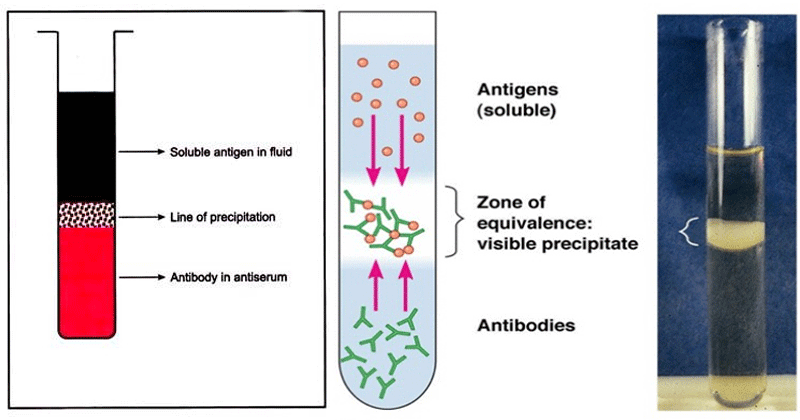- Interactions of antibodies and antigens, in the form of various tests, have been developed to determine the presence or absence of antibodies or antigens in a sample.
- A type of interaction between soluble antigens with its specific antibody in a suitable medium that results into the formation of an insoluble complex that precipitates is termed as precipitation reaction.
- The ring test or the precipitin ring test is a simple serological technique that illustrates the precipitin reaction in solution.
Objectives of Ring Precipitation Test
- To detect antigen-antibody complexes.
- Describe the circumstances under which antigen-antibody complexes precipitate out of solution.
- Detect antibodies in patient serum which can be used to diagnose disease.
Principle of Ring Precipitation Test
The precipitin ring assay is a quick qualitative test for the presence of antigen–antibody complexes. It is based on the principles of the precipitin curve which states that antigen-antibody interact forming cross-linked precipitate when the proper ratio of antigen to antibody is reached. A solution containing the antiserum to be investigated is placed in the bottom of a series of clear test tubes. Solutions containing increasing concentrations of a known antigen are gently layered above the antibody solution. If the test antiserum contains antibody recognizing the antigen, immune complexes will form and be visible as a whitish ring at the interface. The white ring demonstrated is the formation of visible precipitate, a flocculent or granular turbidity, in the test fluid.
Semi-quantitative results can be obtained by comparing the experimental results to those derived from a standard curve constructed using known quantities of antigen and antibody.
Procedure of Ring Precipitation Test
- Test antiserum is introduced into a small diameter test tube.
- Clear solution of test antigen is then carefully added to form a distinct upper layer. Antigen of different concentrations can be used for subsequent tubes in series.
- After 4 hours incubation, the formation of a ring of precipitate at the interface of two liquid layers is checked for.
- The rate at which the visible ring forms depends on the concentration of the antigen.
- For titre determination of antibodies, different dilutions of antiserum can be used.
- The highest dilution with a visible ring is used to determine the titer. The titer is the reciprocal of the highest dilution showing a positive result, expressed as a whole number.
Results Interpretation of Ring Precipitation Test
Positive Result
Development of a white ring at the junction of antiserum and antigen solution indicates positive test.
Negative Result
Absence of a ring formation.
Examples
C-reactive protein (CRP), Lancefield grouping of β-haemolytic streptococci, Ascoli’s thermoprecipitin test for anthrax diagnosis are the examples of the ring test.
References
- Lydyard, P.M., Whelan,A.,& Fanger,M.W. (2005).Immunology (2 ed.).London: BIOS Scientific Publishers.
- Owen, J. A., Punt, J., & Stranford, S. A. (2013). Kuby Immunology (7 ed.). New York: W.H. Freeman and Company.
- Playfair, J., & Chain, B. (2001). Immunology at a Glance. London: Blackwell Publishing.
- Parija S.C. (2012). Textbook of Microbiology & Immunology.(2 ed.). India: Elsevier India.
- http://ecoursesonline.iasri.res.in/mod/page/view.php?id=61673
- http://fac.ksu.edu.sa/sites/default/files/lab_6_ring_test.pdf
- https://courses.lumenlearning.com/microbiology/chapter/detecting-antigen-antibody complexes/

